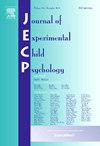Transposed-character effects during learning to read: When does letter and non-letter strings processing become different?
IF 1.8
2区 心理学
Q3 PSYCHOLOGY, DEVELOPMENTAL
引用次数: 0
Abstract
Efficient reading requires the association of different letter identities with their positions in the written word. This leads to the development of a specialized mechanism for encoding flexible location-invariant letter positions through learning to read. In this study, we investigated not only the emergence and development of this position coding mechanism but also whether this mechanism is a consequence of the orthographic code (i.e., letter specific) or inherent to generic visual object recognition. To do so, the same–different matching task was used with children from Grade 1 to Grade 5 (Experiment 1) and with adults (Experiment 2). In both experiments, reference and target stimuli were composed of four-character strings (consonants, digits, and geometrical forms) and could be identical or different by transposing or substituting two internal characters. Analyses of response times, error rates, and discriminability indices revealed a transposed-character effect regardless of the type of characters in Grades 1 and 2, whereas transposed-character effects were greater for letter strings than for familiar non-letter strings in Grade 3, lasting up to Grade 5 as well as in adults. These results provided evidence in favor of a flexible position coding mechanism that is specific to letter strings, which emerges with reading experience as a consequence of parallel processing of letters within words.
学习阅读过程中的转换字符效应:字母和非字母字符串的处理何时变得不同?
高效阅读需要将不同字母的特性与它们在书面文字中的位置联系起来。这就导致在学习阅读的过程中形成了一种专门的机制,用于编码灵活的位置不变的字母位置。在这项研究中,我们不仅研究了这种位置编码机制的出现和发展,而且还研究了这种机制是正字法编码的结果(即特定字母)还是一般视觉对象识别的固有机制。为此,我们对一至五年级的儿童(实验 1)和成人(实验 2)进行了同异匹配任务。在这两项实验中,参照物和目标物都由四个字符串(辅音、数字和几何图形)组成,可以通过调换或替换两个内部字符来实现相同或不同。对反应时间、错误率和可辨别性指数的分析表明,在一年级和二年级,无论字符的类型如何,转置字符效应都存在;而在三年级,字母字符串的转置字符效应要大于熟悉的非字母字符串,这种效应一直持续到五年级以及成人。这些结果提供了支持一种灵活的位置编码机制的证据,这种机制是字母串特有的,随着阅读经验的积累而出现,是单词中字母并行处理的结果。
本文章由计算机程序翻译,如有差异,请以英文原文为准。
求助全文
约1分钟内获得全文
求助全文
来源期刊

Journal of Experimental Child Psychology
Multiple-
CiteScore
4.50
自引率
7.70%
发文量
190
期刊介绍:
The Journal of Experimental Child Psychology is an excellent source of information concerning all aspects of the development of children. It includes empirical psychological research on cognitive, social/emotional, and physical development. In addition, the journal periodically publishes Special Topic issues.
 求助内容:
求助内容: 应助结果提醒方式:
应助结果提醒方式:


